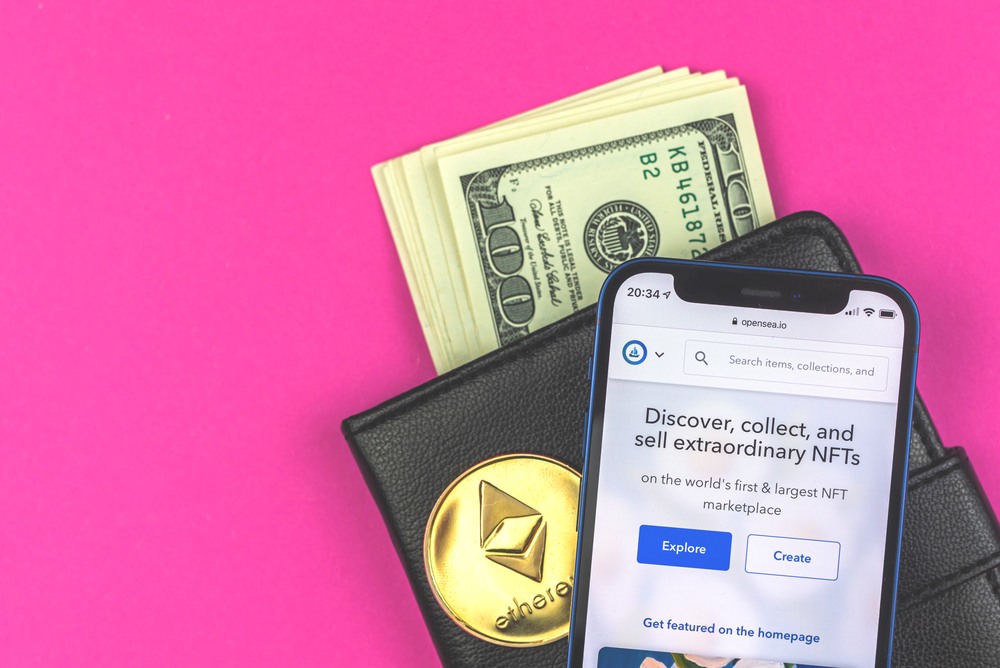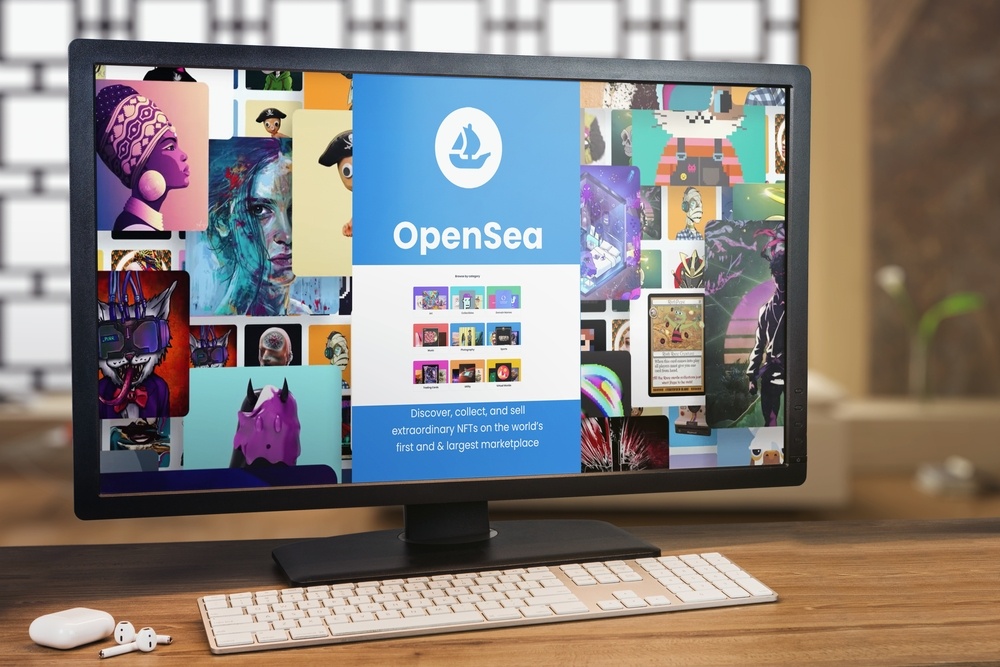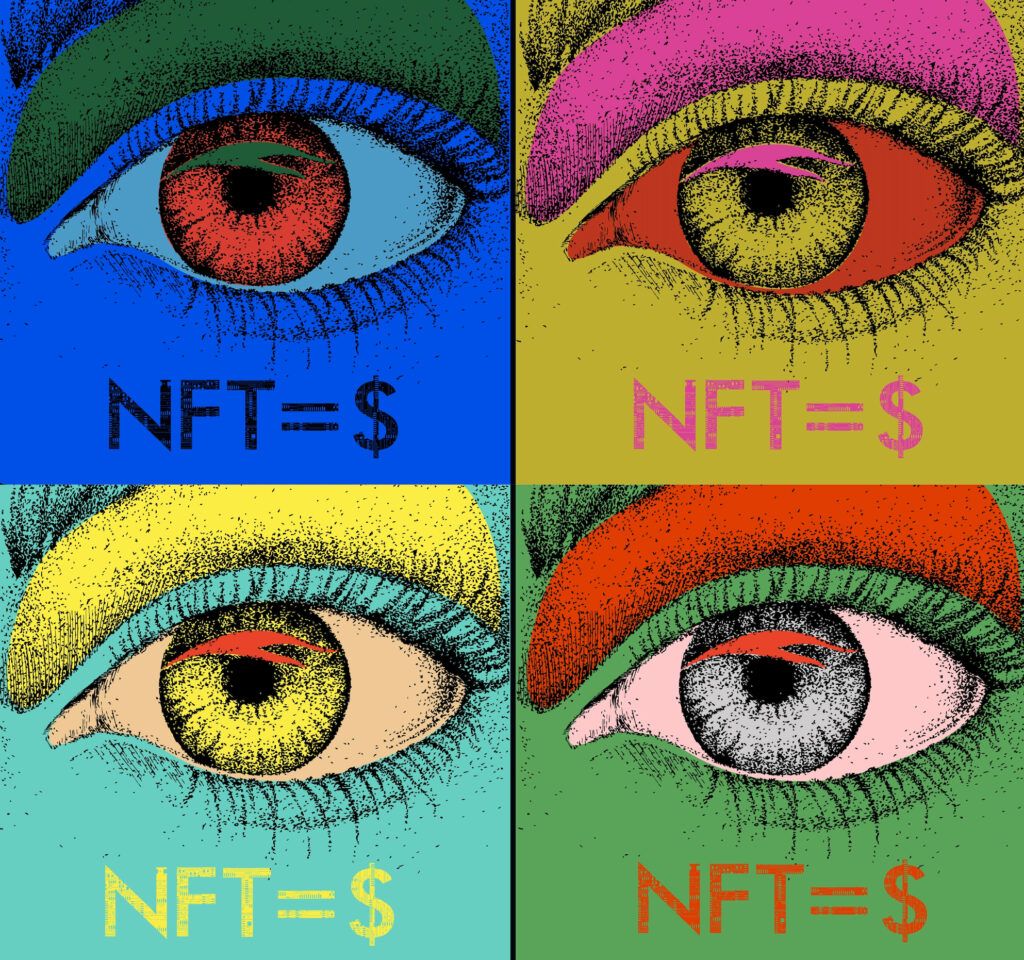
OpenSea is a web3 based platform and marketplace that allows individuals to buy, sell and create NFTs. The two most common methods of making money on OpenSea are by flipping NFTs or creating and selling NFTs.
—>>Build An Income-Generating Website That Lasts Decades!
—>>Watch how I built my business step-by-step in a few minutes.
—>>Earn online income for a lifetime.
>>Start Now<<
You’ve heard of OpenSea. You’re still not really sure what it is, and you wonder how you can make money with it. The article will cover:
- what OpenSea is,
- what NFTs are, and
- how the OpenSea platform works.
The main focus here is on what OpenSea is and how it works. Some NFT basics will be covered as well to paint the clearest picture possible. Along the way you’ll learn about competing platforms, pros and cons of OpenSea, a few top sellers, best practices, prohibited activity and some basic tips for selling your NFTs.
- Getting Into OpenSea & Making Money With NFTs
- What Is OpenSea?
- What is an NFT?
- What is an NFT Platform & Marketplace?
- What is the Ethereum Blockchain?
- OpenSea Competitors
- Mintable
- Foundation
- SuperRare
- Pros & Cons of OpenSea
- + OpenSea Is huge
- + OpenSea Is Ubiquitous
- + OpenSea Is Established & Vetted
- + Deferred minting fees
- + Polygon Minting Option
- + Create NFTs Without Coding
- – Competition & Oversaturation
- – Security Breaches & Theft
- – Limitations & Other Issues
- Top Selling NFTs on OpenSea
- OpenSea Best Practices & Basic Tips
- Prohibited Activity On OpenSea
- What Is OpenSea?
- Bitcoin VS NFTs
- What Are The Real Value of NFTs Art As Sold On OpenSea?
Getting Into OpenSea & Making Money With NFTs
What Is OpenSea?

OpenSea is an NFT platform and marketplace that works with the Ethereum blockchain. If none of that made any sense, there’s no need to worry. Let’s break this down piece by piece.
What is an NFT?
An NFT, or Non-Fungible Token, is in its most basic terms a digital collectible. There’s more to it than that, but for now think of it like a digital version of a trading card (baseball, football, Garbage Pail Kid…).
One key difference between a basic NFT and Ken Griffy rookie card is there is only one of the NFT. It’s literally the only one in existence because there can never be two equal hashes. Before you scream “but I cAn juSt tAke A scReEnsHot!” keep in mind that the screenshot is just a JPEG, while an NFT is a digital receipt.
Another way to think about an NFT in more artistic terms is like The Starry Night or The Birth of Venus. These are famous paintings and there is only one of each in existence. Real ones anyway. You can of course create realistic paintings that copy the images, or even print out canvas prints with ink, but there is only one of the original.
With NFTs, the verification process on the blockchain is the advantage. While you can create an exact replica of a famous painting or trading card which only experts can verify, with a blockchain, basic users can verify its authenticity quite easily.
NFTs present the first opportunity to buy and sell one of a kind digital art in a decentralized, trustless fashion.
What is an NFT Platform & Marketplace?
In the NFT world a platform is, in theory, a decentralized web3 application that allows individual creators to buy, create and sell NFTs. It’s pretty much synonymous with the phrase “marketplace”, which would focus more on the fact that NFTs are bought and sold on these platforms. The main difference between a platform and a marketplace is in my eyes the former enables minting while the latter doesn’t.
Maybe I’m splitting hairs here but this is the terminology I’ll be using throughout this article.
What is the Ethereum Blockchain?
The Ethereum blockchain is the second oldest and largest next to Bitcoin. The Ethereum Main Network runs the Ethereum Virtual Machine. Smart Contracts can be written and stored on the ETH Mainnet. This is how NFTs are created.
OpenSea Competitors

The NFT space is vast and growing at breakneck speed. In 2021 alone total NFT sales soared to $25B. In 2020, they were $94.9 million. The market cap for the entire crypto market is 2.05T. NFTs make up 1.53% of the total crypto space.
Needless to say, OpenSea isn’t the only platform around. There are many competitors and a new one is joining web3 every day.
Despite the ever-growing NFT platform landscape OpenSea is still number one. At least for now.
Three well-known NFT platforms that directly compete with OpenSea are: Mintable, Foundation and SuperRare. There are plenty more. You can learn more about some of them in my 11 Places To Sell NFT Art article. Keep in mind, these are all for Ethereum blockchain based NFTs. You can also mint NFTs on other blockchains like Solana or Cardano.
Mintable
Mintable is an established NFT platform that got its start in 2018. It’s one of the more well-known NFT platforms and has a good-sized user base. Mintable was the first NFT platform to offer the option to mint without a GAS fee. Mintable allows artists to maintain ownership of the Smart Contracts for their NFTs, unlike many of the other NFT platforms.
Foundation
Foundation is a newer curated NFT platform that started in 2020. It’s built on the Ethereum Blockchain so buyers use ETH to purchase NFTs. Foundation is a closed platform with an invite-only acceptance process. To begin minting NFTs an artist must get an invite from an existing Foundation creator who’s sold at least one NFT.
SuperRare
SuperRare is somewhat of an established NFT platform that got started in 2018. The platform has a bit of an emphasis on exclusive art. SuperRare works with the Ethereum Blockchain and token. Payment methods for buyers consist of credit, debit, and even PayPal.
Pros & Cons of OpenSea
Everything it seems has benefits and drawbacks, even NFT platforms, including OpenSea. Let’s take a look at the pros and cons of using this particular platform for minting and selling NFTs on Ethereum.
+ OpenSea Is huge
One major positive aspect of OpenSea is the size of the platform. It’s a bit of a double-edged sword, but your work is in a pool with thousands of others. This is good because it presents the opportunity for buyers searching for NFTs that might not know who you are to find your work.
+ OpenSea Is Ubiquitous
When a lot of people think of NFT, they think of OpenSea. They might not even be aware of it. NFTs from outside OpenSea can also be found for sale in its marketplace.
+ OpenSea Is Established & Vetted
It’s established, vetted and the most widely used NFT platform to date. It’s been used by a lot of people safely. For the most part.
+ Deferred minting fees
The cost of minting an NFT, especially on the ETH Mainnet, can be costly. OpenSea offers creators the opportunity to pass the minting fees along to the buyer of their NFT at the time of purchase.
This is great for creators who want to start minting their work and making it available without having to spend a fortune on GAS fees creating their NFTs.
+ Polygon Minting Option
OpenSea offers creators the option to mint NFTs using the Polygon cryptocurrency. The typical token used for minting NFTs on the ETH Mainnet is Ethereum itself. The GAS (or transaction) fees associated with ETH can be outrageous.
Polygon doesn’t have the same problems with transaction fees that Ethereum does. We’ll skip the details of why. Polygon is more or less free in terms of minting NFTs.
+ Create NFTs Without Coding
NFTs are created using Smart Contracts. They are written in a programming language called Solidity. The Smart Contracts are stored on the blockchain and NFTs are minted from them.
One approach to creating NFTs is to write custom smart contracts and build a custom website that buyers mint NFTs from. This is a highly customizable path and provides a lot of flexibility in how NFTs are created and work.
Writing a custom smart contract and building a custom website for minting NFTs can be a time and capital intensive task.
OpenSea allows creators to use a web based interface to create NFTs. It also provides a facility to list NFTs on their marketplace for buyers to browse and purchase. This saves a lot of time for creators. Especially anyone just wanting to test the NFT waters.
OpenSea is easy to use, and there is no programming involved. Unless you want. You can also import your own custom smart contracts into OpenSea.
While there are tons of great reasons to use OpenSea, not all that glitters is gold. From breaches, to theft and limitations OpenSea has drawbacks and issues. There has even been criticism and skepticism surrounding just how decentralized it really is.
– Competition & Oversaturation
OpenSea has one million active user wallets. Not all of these are for creators but it still provides an idea of the size and magnitude of the platform. As a creator your NFTs are sold in the marketplace alongside everyone else.
It can be nearly impossible to find a new, unknown creator on OpenSea because of the sheer amount of other NFTs. With the current NFT gold rush and bubble thousands of projects are flooding into the market every day.
– Security Breaches & Theft
Crypto in general is ripe with scams, rugpulls and a wide array of other fraudulent behavior. It’s a very risky place.
NFTs exist within the crypto ecosystem so they’re no exception. The NFT space at large has seen countless issues in the last couple of years. OpenSea has its place in the mess.
As far back as September 2021 there have been people reporting issues with OpenSea security. One report even states users could “upload an .SVG file containing a malicious payload, which would execute under the OpenSea storage subdomain.” Yikes.
More recently, 1.7M worth of NFTs were heisted from the platform. OpenSea has even been named in a lawsuit involving one of the popular and valuable Bored Ape NFTs.
The only safe thing to say is that OpenSea has some potential security issues.
– Limitations & Other Issues
A few of the more major limitations with OpenSea are an inability to split payments for NFTs, secondary royalty maximums, inability to attach or embed licenses, 100MB file size cap, limited customer support and endless copycat creators and forgers. There’s more than a few issues if you start digging.
There is definitely a divide in the public eye surrounding NFTs in general. With the recent issues OpenSea has faced and other scandals going on in the space it’s easy to understand why. A potential negative for artists creating NFTs is the negative stigma being attached to them. It may come or go, time will tell; it’s something to keep in mind though.
Top Selling NFTs on OpenSea

So who are the top NFT creators running the show on OpenSea? Using the top NFTs page on OpenSea, you can see which projects have been popular in the last 24 hours, and the last 7 days. Seven days isn’t a very long time period, but things move fast in the world of crypto.
Though NFTs have been around for many years, the recent buzz about the is relatively fresh, and there are just a few projects that are internationally well-known. CryptoPunks, Bored Ape Yacht Club, Decentraland and The Sandbox are just some a few projects which are becoming known as Blue Chip NFTs due to their consistent popularity and high prices.
It’s important to note most, if not all of these popular NFT projects on OpenSea weren’t originally minted there. As I mentioned earlier, not all NFTs are on Ethereum. Many of the most popular projects you’ve heard about were created with custom smart contracts with custom minting websites. They also have enormous marketing budgets and/or strategies in a lot of cases.
This is an extremely important aspect of OpenSea to take into consideration. The marketplace is flooded with NFT projects that aren’t necessarily native to OpenSea. This leads back to the issue with OpenSea being over saturated and your art standing next to thousands of other creators.
Another aspect of NFTs at this level is they’re on the eth Mainnet. These are the million dollar NFTs you keep hearing about in the news. This type of NFT is of insanely high risk, reward, desire and exclusivity. Very often, it’s hard to sell anything on Ethereum Mainnet because of high gas fees. It makes sense to pay $400 to buy a $10,000 NFT but if your NFT isn’t worth at least a few eth, then you may want to consider the flourishing Polygon NFT ecosystem for smaller creators. The amount of people trading with Polygon on OpenSea has spiked to over 800K in Jan 2022 from only 15 in June of 2021.
A few of the top Polygon projects on OpenSea right now are: ZED RUN Legacy, Ember Sword Land and DeRace Horses. Another, higher dollar one is Crypto Unicorns Market.
If you’re a smaller, unknown artist with a small fan base it might be harder to fetch top dollar for your work. Polygon enables buyers to collect your art and not pay huge GAS fees, ever. It essentially enables a completely different NFT market for non-crypto-whales.
With a total over 166,123,856 Polygon NFTs at the time of this writing, there’s plenty of opportunity.
OpenSea Best Practices & Basic Tips

NFTs and the platforms and marketplaces they’re minted, bought, sold and flipped on are the wild west. I cannot emphasize this point enough.
If there were a best practice in the actual Wild West it might be something along the lines of: shoot quick, accurately and with intention. That’s not a bad way to look at NFTs in general.
Branding | Create a strong brand for your artwork. Make sure you have a nice header image added to your OpenSea account. Also, use a strong piece of work, perhaps a logo or one of your NFTs, for your profile picture.
Social Media | Add all social media accounts and links to your OpenSea profile. If you can verify your account do it by all means. This will require your Twitter or Instagram account to be verified.
Pricing | Plan out your pricing and research other similar projects. Don’t expect the world. Start small. You can aim high but don’t exceed your competitors’ price by 100x.
Marketing & Promotion Planning | Figure out your marketing plan and a few promotion ideas before you even create your OpenSea account. The more time you spend researching and planning, the better your chances are for actually selling NFTs.
There have been some crazy stories, but don’t count on it. Due to the size of OpenSea don’t rely on minting and forgetting. The chances are extremely low you’ll sell anything.
Collection Strategy | Using a Collection is a requirement on OpenSea. Strategizing the total number of NFTs in a collection is important for example. I would consider Collection strategy to be a best practice. Each NFT is contained within a Collection of similar, yet varied images.
Each Collection on OpenSea has a Floor Price. It’s the lowest price for one NFT in a project. Floor price is a widely used metric to assist in valuing projects.
Build & Engage Community | Building a community around your NFT project is very important. Setting up a Discord and providing project road maps, updates, giveaways and support is standard for quality NFT projects.
Create Whitepaper | Write a Whitepaper for your NFT project. Use this as an opportunity to plan out and define your long term goal and vision. Share this with fans, buyers and supporters of your work.
Release a Roadmap | Once you’ve written a Whitepaper for your project you can extract the key points and begin to assign a timeline to the project. Create a Project Roadmap and define the critical moments ahead.
Set Fair Secondary Royalty | Set an appropriate secondary royalty amount and consider your buyers. How much of a percentage of their future sales are you taking? Is it industry standard depending on what type of NFT you’re selling?
NFT & Project Naming | Name the individual NFTs and their collections. Everything needs to look as pro as possible for your entire project. This includes the names of the art and the collections. By default, OpenSea will use random names for collections, make sure you’ve named yours.
Provide Utility | Considering utility for your project is also important. There are many ways to provide utility but I think really getting creative and breaking the mold is a bit of an untapped opportunity still.
Prohibited Activity On OpenSea
Like any other platform these days there is a huge terms of service agreement. It’s not a terrible idea to read through it yourself, especially if you’re considering selling any volume of NFTs through OpenSea. Here are the parts from the TOS that are applicable to creators and content. These are all directly prohibited activities on OpenSea.io:
- Infringe or violate the intellectual property rights or any other rights of others
- Create or display illegal content, such as content that may involve child sexual exploitation
- Create or display NFTs or other items that promote suicide or self-harm, incites hate or violence against others, or doxes another individual
- Use the Service for any illegal or unauthorized purpose, including creating or displaying illegal content, such as content that may involve child sexual exploitation, or encouraging or promoting any activity that violates the Terms of Service
- Engage in behaviors that have the intention or the effect of artificially causing an item or collection to appear at the top of search results, or artificially increasing view counts, favorites, or other metrics that OpenSea might use to sort search results
- Distribute spam, including through sending unwanted NFTs to other users
- Use or attempt to use another user’s Account without authorization from such user
- Pose as another person or entity
- Claim an OpenSea username for the purpose of reselling it or otherwise engage in name squatting
- We allow users to post NSFW content, but that content and other associated material is subject to being marked NSFW and may be handled differently than non-NSFW content in navigation menus and search results.
The funny part about OpenSea having a “terms of service” is that it pretty much invalidates the idea of this being a decentralized platform for censorship resistant art. If you violate the TOS, they’ll simply remove your NFTs. Even worse, violations of the TOS are human moderated, so the rules are selectively enforced.
Knowing this, it’s hard for me to recommend NFT art as anything groundbreaking other than a temporary window of opportunity for artists to sell their digital art. In my opinion, the buzz will fade over time, then drop off a cliff as people realize that most digital art will not gain value over time. With the exception of a few high profile images, it’s likely that almost all NFTs will lose value over time. Personally, I think we’ve hit peak NFT and will only see the market as a whole go down starting in 2022.
Bitcoin VS NFTs
The difference between a truly decentralized digital token like Bitcoin and NFTs is that bitcoin is fungible and divisible, meaning it can be used as money. I can trade a car for some bitcoin because I know the bitcoin can be later used to buy groceries. The same can’t be said of a Bored Ape, which cannot be divided and is only worth as much value as someone is willing to price its aesthetics.
Even as a store of value NFTs are a high risk endeavor. Sure, buying a Picasso a hundred years after his Blue Period, while his name is already written into the history books can be a reliable store of value. Now imagine going back to 1901 and surveying all the painters at that time and choosing Picasso out of the bunch. Impossible. The idea that you’re going to find the one digital artist who is currently creating art that will be desirable and valuable a century into the future is many levels beyond wishful thinking.
What Are The Real Value of NFTs Art As Sold On OpenSea?
NFTs on OpenSea are not immutable. When the platform disappears, the art disappears. The real value of NFT art as it is sold on OpenSea is supporting artists whose work you enjoy. Like purchasing a vinyl record of a song you can just listen to on Apple Music or Spotify for free, the buyer gets the benefit of owning a collectible and supporting art they enjoy, and the artist, though creation, marketing, and consistency can earn a living from their work.
This can be a beneficial relationship between the right buyer and seller, and I think it’s great that some artists are able to make money this way. My advice to the buyers is just to not get caught up in the hype thinking you are going to get rich flipping NFTs.
What’s up ladies and dudes! Great to finally meet you, and I hope you enjoyed this post. Sign up for my #1 recommended training course and learn how to start your business for FREE!
